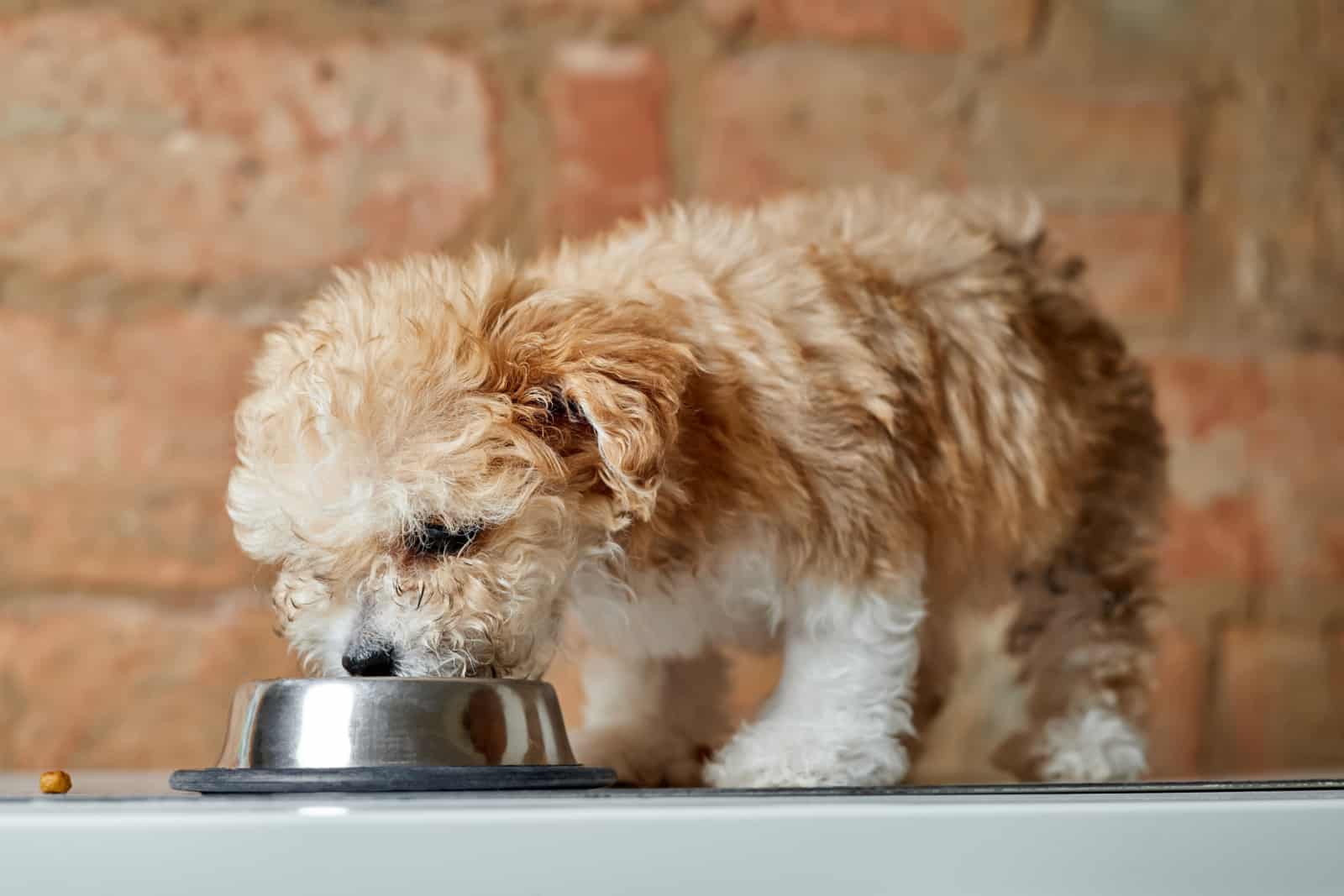Designing a decent Maltipoo feeding chart is one of the first things that every respectable owner should do once they introduce a puppy to a new home. That way, the owner will easily maintain his/her puppy’s needs, as well as keep the Maltipoo within a desirable weight.
In order to create a valuable feeding schedule for your puppy, you need to take into account several things such as the dog’s breed, age, current weight, and desired weight.
Furthermore, each owner has to make a clear distinction on what their puppy should and should not eat.
Once the feeding chart is made, you have nothing left to do but keep the wheel straight and enjoy the ride. So, let’s find out what the basic Maltipoo feeding chart should look like!
Maltipoo Feeding Chart
[table id=726 /]
Maltipoo Puppy Feeding Chart
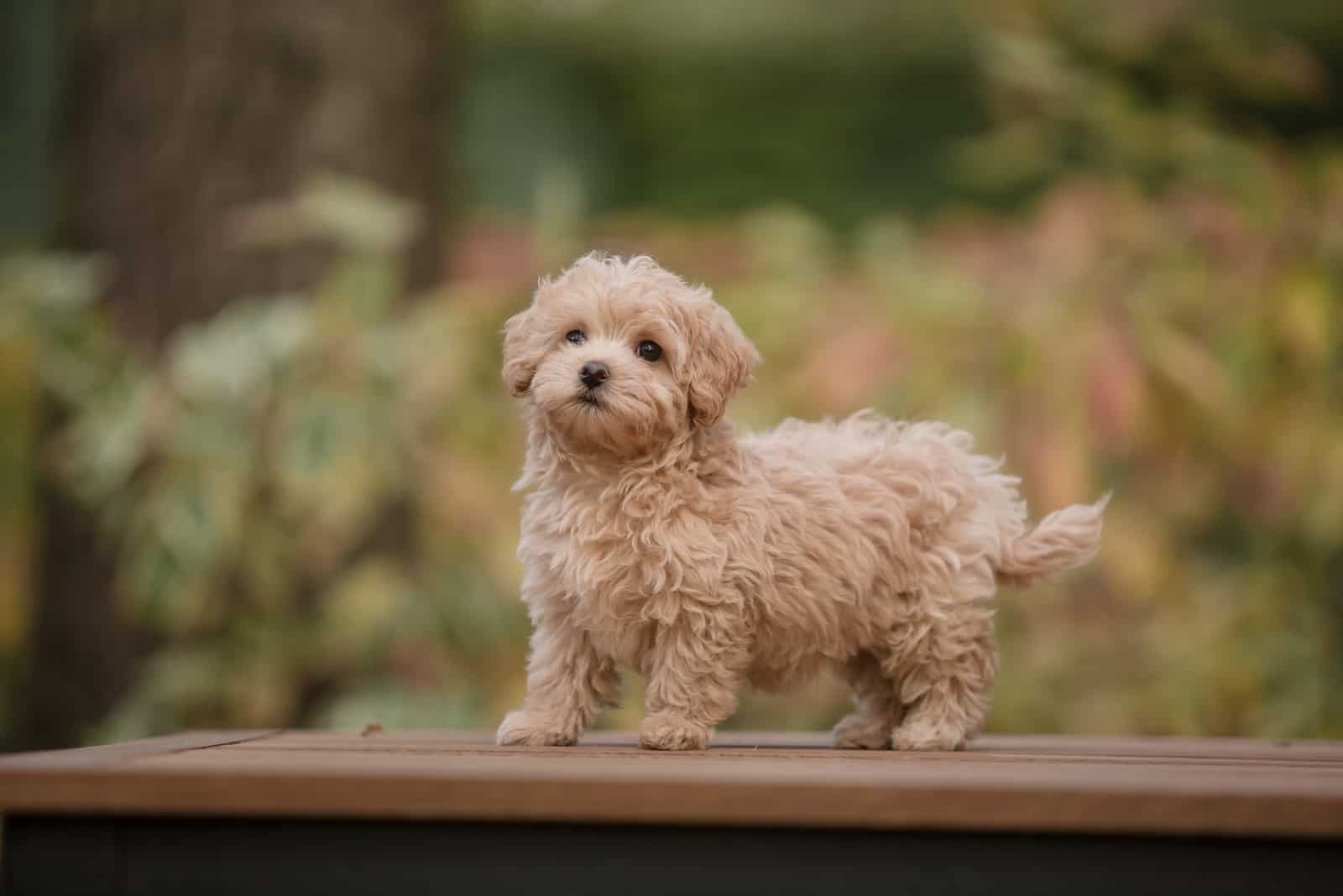
Assuming that you have purchased a Maltipoo puppy from a reputable breeder, you are most likely to have your new companion in your home at eight to ten weeks of age. That being said, a Maltipoo that old should already be weaned off its mother’s milk and be eating puppy food.
Still, take into consideration that these canines belong to the category of toy to miniature breeds, which means that they generally need more frequent meals to maintain their energy.
Puppies at eight weeks of age are still too young to be treated as an adult. Therefore, you shouldn’t keep them on a strict feeding guideline yet. They should have food available at all times, as well as fresh water. Maltipoo puppies at this age don’t eat much in one meal.
They rather have seven to eight smaller meals – typically, a gruel of high-quality wet food combined with water.
If, by chance, you happen to adopt a Maltipoo from a rescue, or get one from a street right after it was born, their feeding schedule will be somewhat different…
First Two Weeks
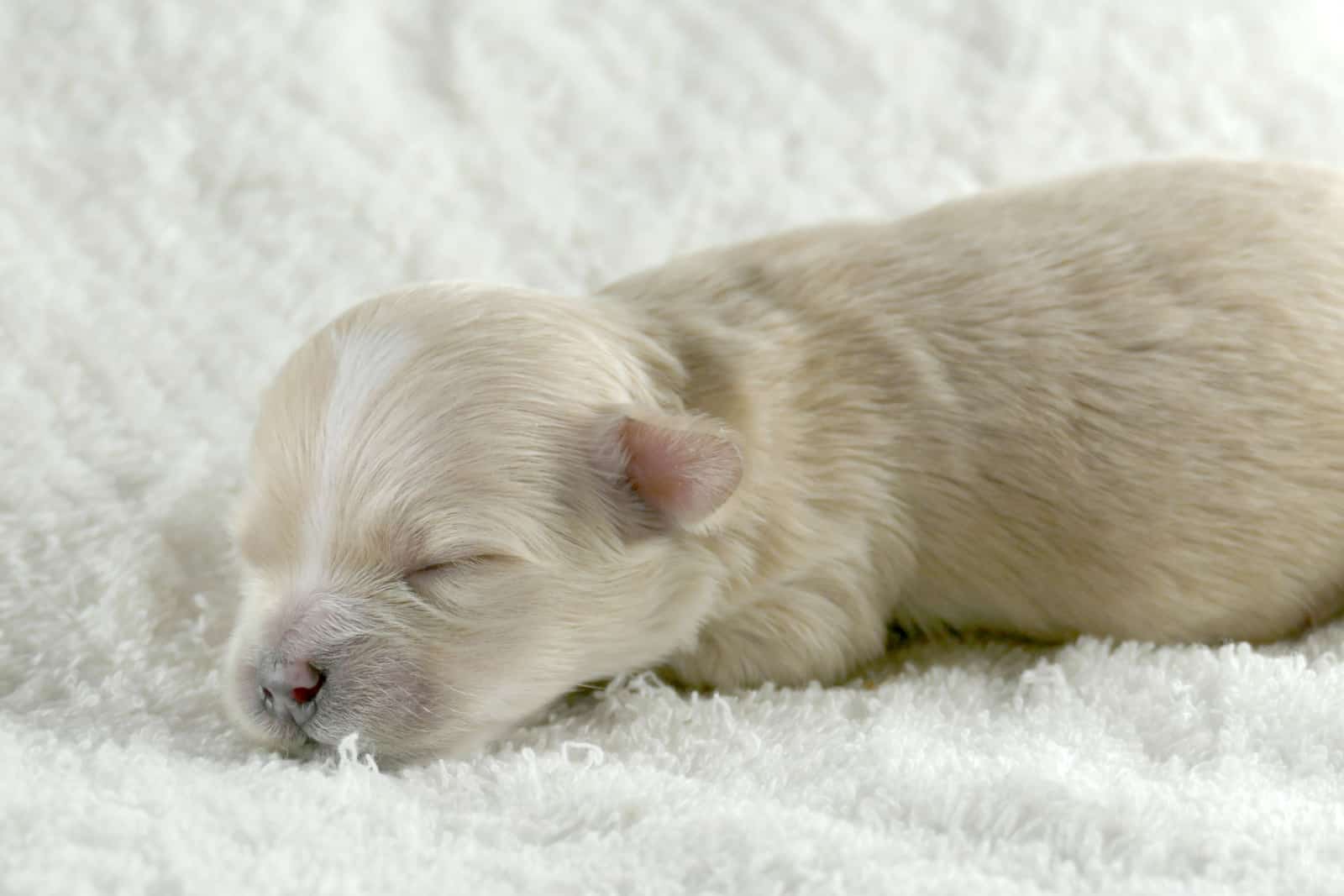
The first two weeks are probably the most sensitive period in any dog’s life. This is due to the fact that newborn puppies are still too weak to maintain their body temperature, as well as to feed themselves without any problem.
The main source of dog food during this age is mother’s milk. On the other hand, being next to the mother is how newborn puppies are heated.
Still, if you don’t have the luxury of putting your newborn companion next to its mom, then a milk replacer is the only food you should give your Maltipoo.
Remember that newborns have a sensitive stomach and a weak digestive system. That’s why cow’s milk is not an option… ever.
After the first couple of weeks, puppies usually display their first teething symptoms. Alongside this cute act, they should be slowly weaned off their mom’s milk. Adapting to a new food is a slow process, so don’t rush it.
You should always prepare a feeding schedule according to your puppy’s age, weight, and other visible factors, such as the Maltipoo’s gradual progress in terms of growth. Bear in mind that some puppies tend to be bigger than others in this age, which is completely normal.
Adjusting To Puppy Food
After you have overcome the most critical period in your puppy’s life, it is time to start introducing your Maltipoo to regular puppy food.
That being said, three-week-old Maltipoos are old enough to start tasting their first gruel of wet and dry puppy food, combined with a milk replacer.
Even though there is a plethora of affordable pet food available on the market – make sure you get the best for your Maltipoo.
Purchasing reliable dog food is the number one thing in a Maltipoo feeding chart. You want to avoid unhealthy meat by-products and artificial additives.
Instead, go for food that contains high levels of calcium and phosphorus – the two minerals that are crucial for the development of your puppy’s bone structure.
The weaning process generally lasts until puppies turn seven to eight weeks of age. That’s why you shouldn’t fully transfer them to puppy food until then.
Even though many dog owners forget about this fact, keeping your dog stress-free is one of the most important things during the process of adaptation to a new food. Stressed puppies will generally adapt to puppy food a lot harder than their carefree buddies.
That said, you should keep your three-to-eight-week old puppies in a nurturing, low-volume environment in order to give them time to adapt.
How Much Should An Eight-Week-Old Maltipoo Eat
Have you just got a new Maltipoo, and you’re wondering how much to feed an eight-week-old puppy? Well, here’s a simple formula…
For starters, you should take into consideration that these puppies are generally a toy to miniature dog breed. That said, the Maltipoo feeding chart prescribes several frequent meals during the day to maintain their energy on a normal level.
However, a regular Maltipoo should eat no more than half of a cup on a daily basis. These are not exactly the most active breed in the world, which means that they don’t need as much food as standard Poodles or some other large breed.
Typically, Maltipoos under three months of age should have food available at all times. They can’t process as much food as needed during one meal, which means that five to six meals a day will be required to fulfill their needs.
Eight-week-old puppies need food enriched with protein that is derived from chicken, lamb, turkey, and fish. Furthermore, these pooches need green vegetables enriched with fibers for easier digestion.
Lastly, healthy fats are a good source of energy, so adding coconut oil and fish oil would be a smart choice, too!
Three To Six Months Old Maltipoos
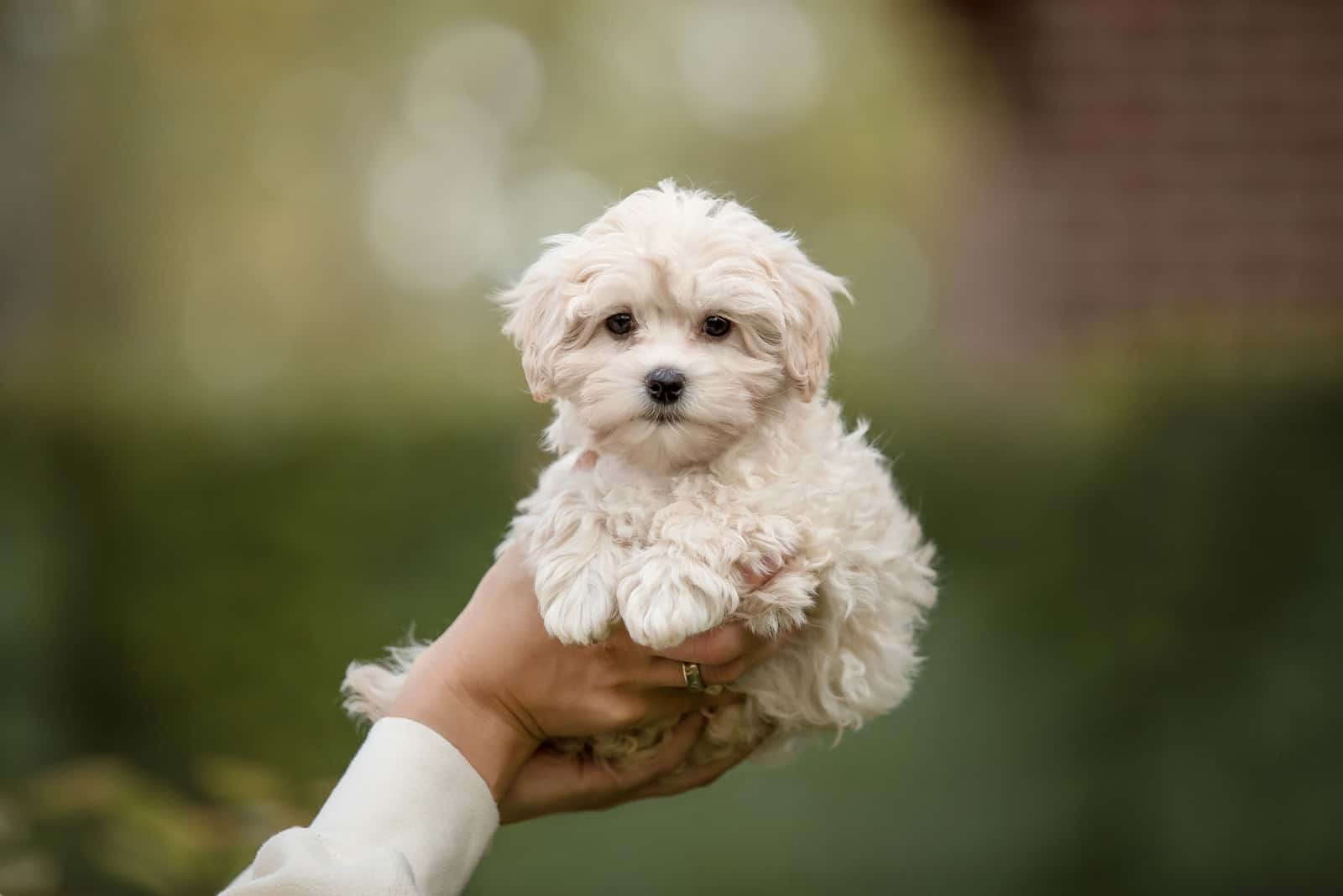
Three-month-old Maltipoos are old enough to be playful, active, and socialized. Alongside their mental development, the amount of food you give them should be increased, too. Half of a cup for puppies under 10 pounds should still be enough.
On the other hand, puppies that are above 13 to 14 pounds can easily take up to one cup of high-quality wet food per day.
Still, the number of their meals should be decreased down to three or four. Maltipoos between three and six months of age typically eat every four to five hours as they no longer need as frequent of meals as when they were in the phase of early puppyhood.
Bear in mind that these pooches, alongside their diet, require at least twenty minutes of exercise on a daily basis. Despite the fact that this is a small breed, Maltipoos still need moderate training to burn off their energy.
Coming from two dogs that belong to the club of the best family dogs in the world, Maltipoos won’t mind spending the whole day on your lap. Therefore, you should stimulate their activity by creating new ways of entertainment in order to keep them engaged.
At this age, puppies will normally eat wet food and a kibble. Still, you should always choose small kibble for these canines as a Maltipoo dog’s teeth and jaws are still not as developed as in an adult dog.
Six To Eighteen Months
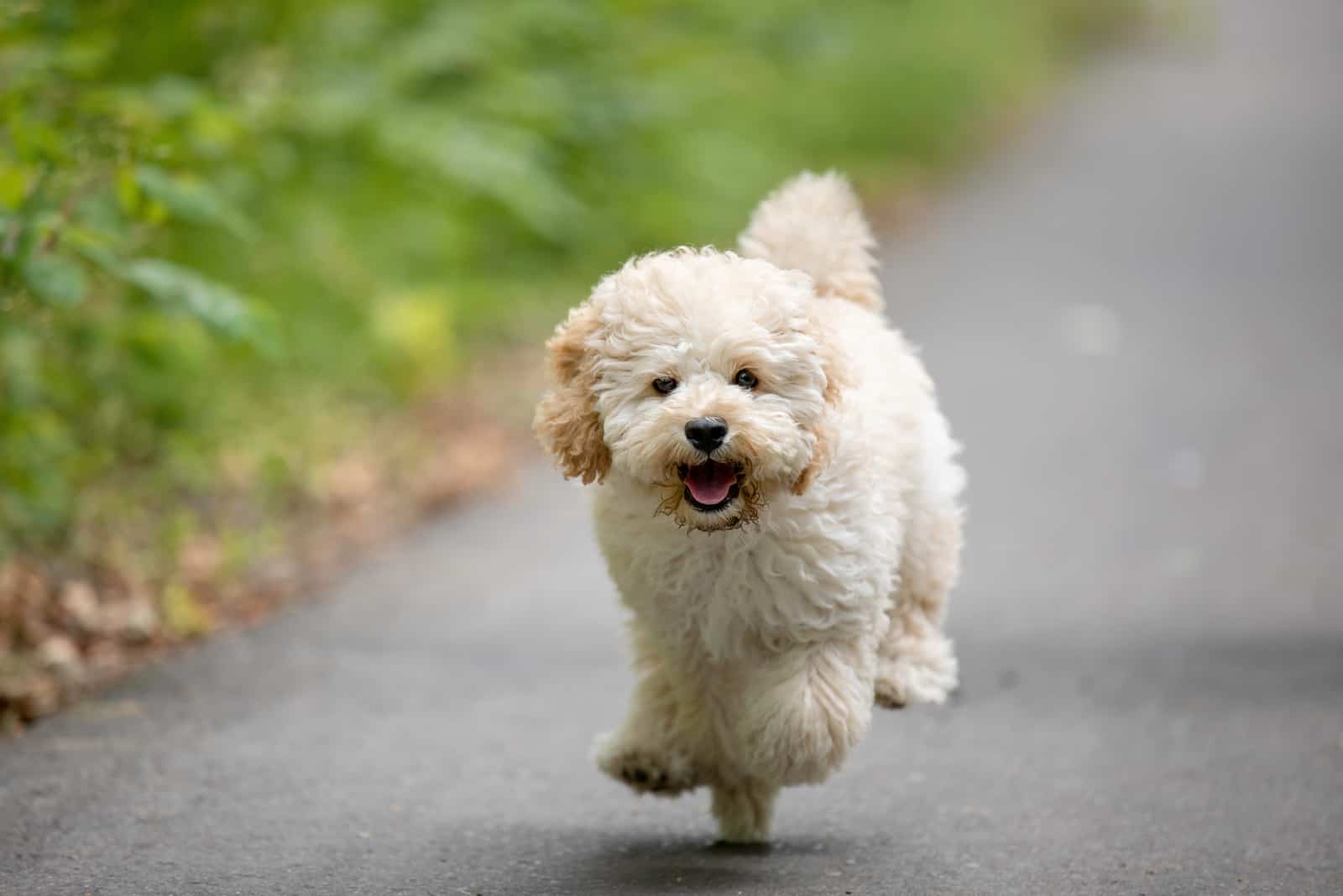
During their sexual maturity phase, which starts at six months of age, your Maltipoo is most likely to display untypically active behavior. That said, puppies that burn off significantly more energy at this age will need a medium to large quantity of food on a daily basis.
However, bear in mind that ‘‘large’’ means no more than one cup in the Maltipoo feeding chart. These are still quite small dogs that don’t need as much food as GSDs or Dobermans.
In fact, teacup Maltipoos will probably need no more than half to 3/4 cup during the day. If you happen to have a teacup puppy in your home – don’t reduce the number of meals (at least three to four).
If, by chance, you have a regular-sized Maltipoo, you can reduce their number of meals down to two once they turn twelve to eighteen months of age.
Puppies older than eighteen months are already considered to be adults, which means that they can easily have two regular meals during the day.
You shouldn’t reduce this number down to one as these pooches are not strong enough to be eating just one meal on a daily basis.
In fact, eating two regular-sized meals will keep them active and energetic, and at the same time, it will prevent stomach torsion.
What Kind Of Food Should My Maltipoo Eat
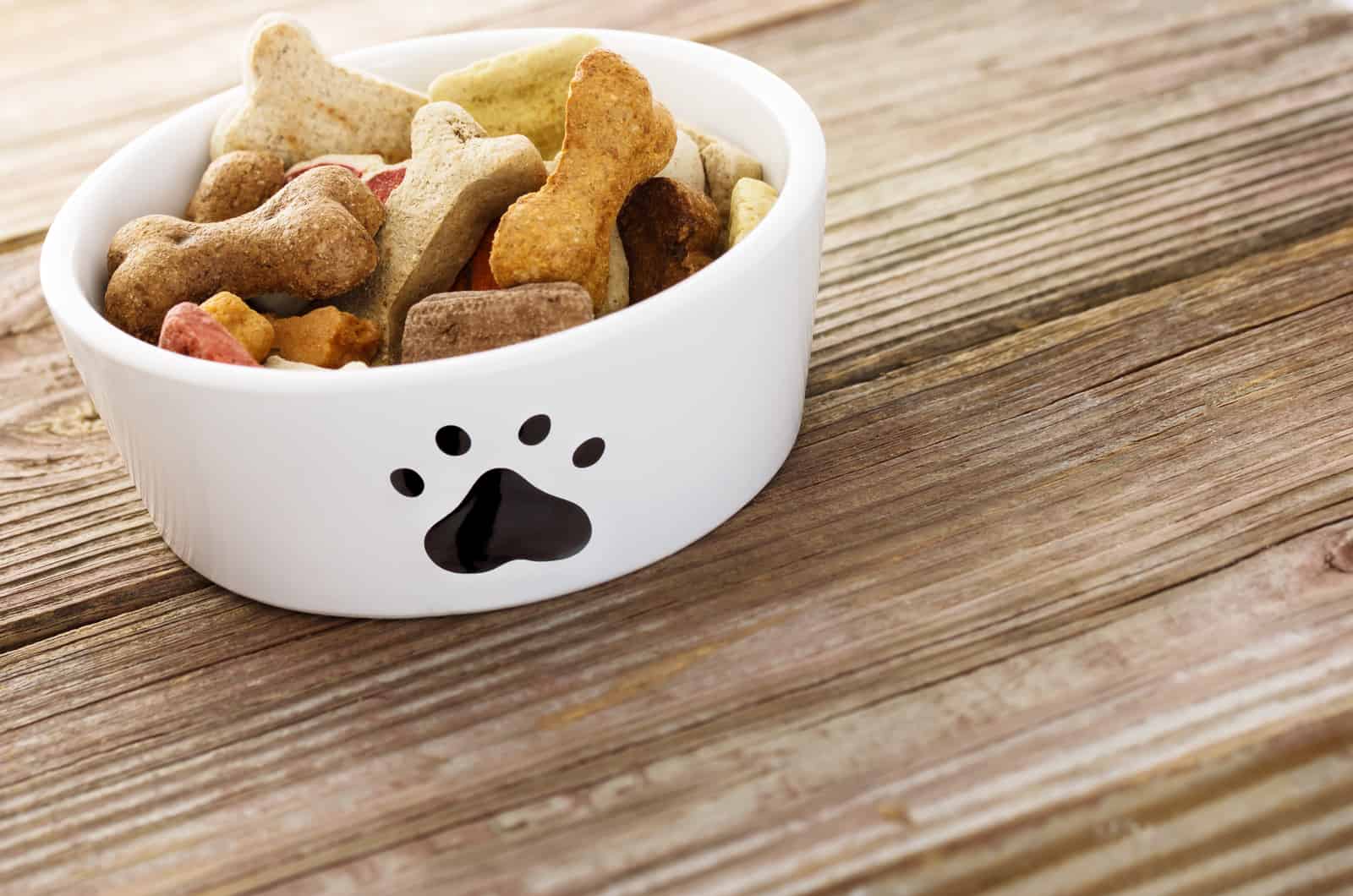
Just like any other dog breed, these canines will be perfectly satisfied with eating wet food, dry food (popularly known as kibble), and even homemade food.
The phenomenon of a raw food diet is still widely discussed among Maltipoo breeders and owners. This is due to the fact that these small canines can have occasional problems with digesting raw food.
Their stomach is far more sensitive than in large breeds, which is why raw food is sometimes not the greatest thing to implement in a Maltipoo feeding chart.
Still, if you’re inclined to give them raw food, you need to calculate the appropriate amount. Always take into consideration their current age, weight, energy level, and body condition.
Wet Food
When it comes to wet dog food, the most important thing is to stay away from the worst-quality brands on the market. This way, you will prevent a plethora of side-effects such as diarrhea, bloat, stomach problems, constipation, bad breath, and liver problems.
Wet food is an excellent source of energy. Furthermore, wet food is a great option if your dog doesn’t drink as much water as required. Wet food itself contains water, which reduces the possibility of your dog having kidney or gastrointestinal issues.
Giving your dog wet food is a great way to round up a healthy diet as wet food contains all the necessary ingredients. Still, the combination of wet and dry food is probably the best choice you can make as dry food boosts dental health in your dog.
Kibble
Kibble, or dry dog food, is another recommended kind of food that you can feed to your Maltipoo. Still, when it comes to choosing the proper size of kibble, you should always choose the small one.
Generally, mini doodle breeds don’t have as big of a jaw as large dogs, which is why small kibble suits them better. Small kibble is even recommended for adult dogs.
Giving kibble to a dog improves its dental health. It encourages the dog to chew prior to swallowing, which results in good digestion and cleaner teeth. However, you should not make kibble their only food.
The combination of kibble and wet food is the best way to round up your dog’s diet as kibble itself is not enough.
In fact, relying only on kibble can trigger severe kidney disease.
Homemade Food
Some dog owners prefer preparing their own dog food, which is perfectly fine as long as you stay within recommended guidelines.
Basic homemade remedies that you can prepare for your Maltipoo are bananas, broccoli, carrots, other green vegetables, potatoes, rice, peas, beef, turkey, and scrambled eggs.
Boiled chicken is an excellent option, too, if you want your Maltipoo to have a lean source of protein. Alongside turkey, chicken is generally one of the best foods that you can give to your dog as it contains healthy fats and protein at the same time.
On the other hand, beef contains a higher amount of fats, which can easily lead to obesity.
Which Foods You Shouldn’t Give To Your Maltipoo
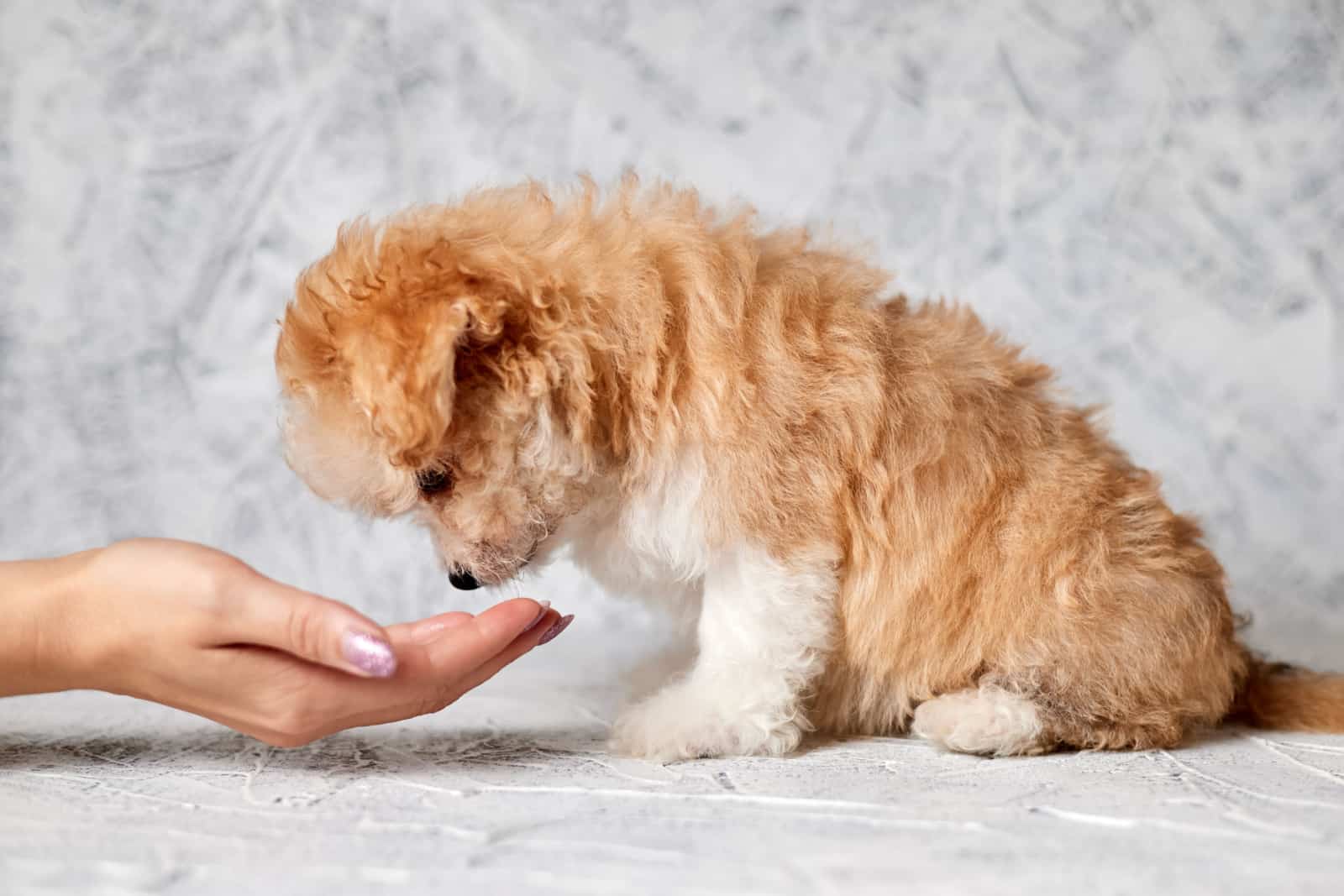
As much as it is important to pay attention to what you give your dog to eat, it is equally important to know what you should never feed your dog. That’s right. Dogs are also intolerant to some foods, while certain ingredients can even be toxic or lead to severe health issues.
If you’re wondering if a dog can eat bagels or some other human food, the answer is – never! In fact, here’s the list of basic don’ts in a Maltipoo feeding chart!
Table Scraps
As much as it feels cute and bonding, giving your dog table scraps is never a good option. Table scraps, alongside junk food, increase the possibility of excessive weight gain, which can lead to further health problems such as diabetes, cataracts, and heart disease.
Even though the amount of food that you give to your Maltipoo is the number one trigger for obesity, inadequate type of food is a close second. Foods such as whipped cream, cookies, pasta, burgers, and bread can easily affect your dog’s digestive system and cause bloat.
Chocolate
Even though it sounds harmless at first, chocolate can indeed hurt your dog.
A molecule called theobromine, which is found in chocolate, can increase the blood flow to your puppy’s brain. Consequently, it makes it hard for your dog to process it, which can further lead to poisoning.
Furthermore, eating a small piece of chocolate can cause puppy diarrhea at night, as well as significantly affecting your Maltipoo’s health. Symptoms such as restlessness, vomiting, panting, and excessive heart rate are just some of many triggered by chocolate.
Milk And Dairy Products
It is widely known that dogs are lactose intolerant, which means that they cannot drink milk, nor can they eat any dairy product. That said, giving your dog sour cream, blue cheese, or any product containing milk can lead to diarrhea and vomiting.
Furthermore, some dairy products can trigger a skin allergy in a dog. If your puppy is constantly scratching, or it has unusual lumps on its skin – reconsider its diet.
Garlic, Onion, And Spicy Food
All three of these can be toxic to your dog. Garlic and onions are known to contain thiosulfate, which can damage your puppy’s blood cells and cause anemia.
Furthermore, eating garlic, onions, and spicy food can have unpleasant repercussions such as diarrhea, vomiting, and loss of appetite.
How To Deal With An Overweight Maltipoo
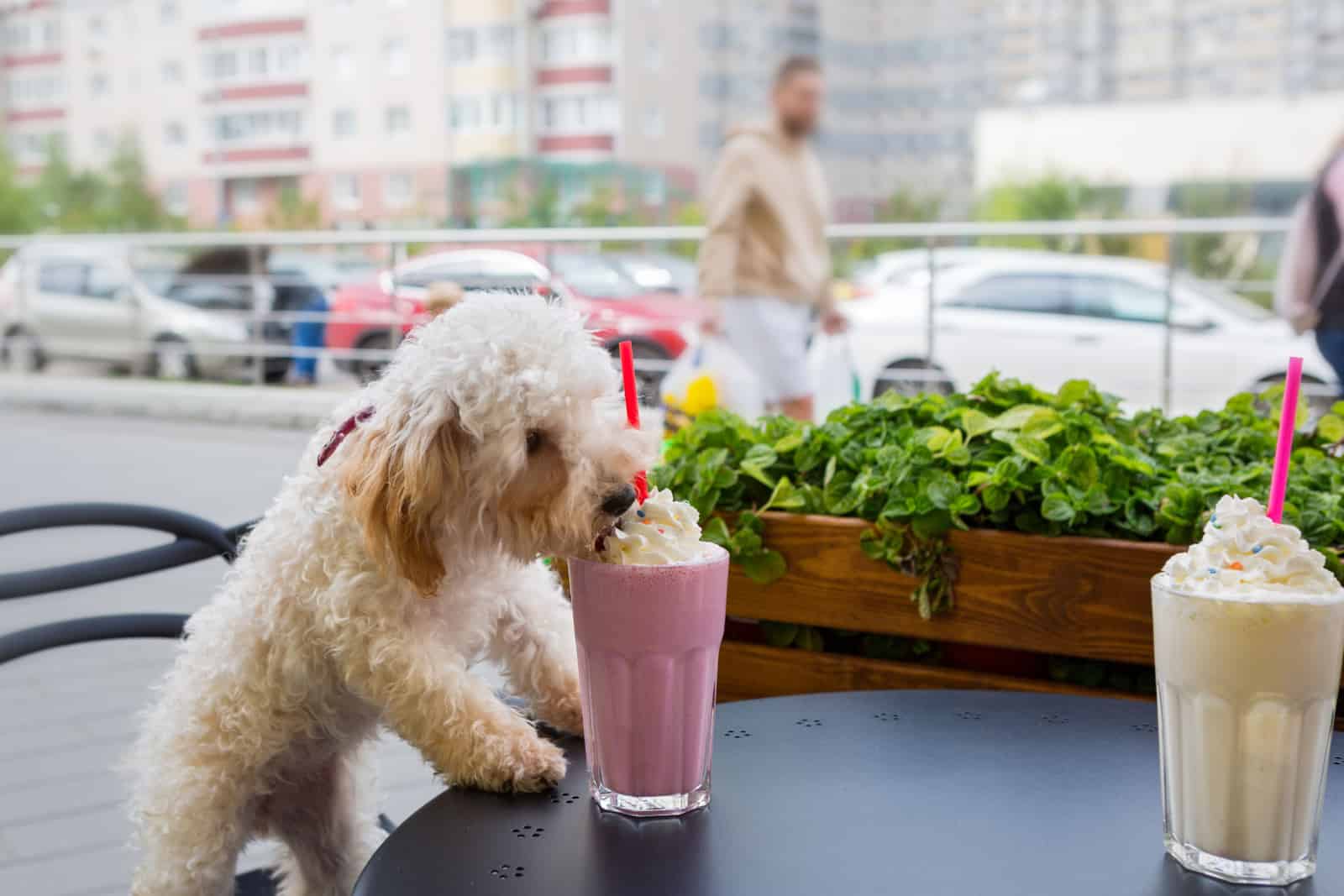
Keeping an eye on your Maltipoo’s growth chart is always a good idea, as well as monitoring its feeding habits. There are three things any respectable owner should do to address their puppy’s obesity: dieting, exercise, and subjecting their dog to regular vet appointments.
Dieting
A Maltipoo’s diet should be strict and rigid. That said, you should know that these canines are not meant to eat as much as some other large dogs.
In fact, the daily amount of food that you give to your Maltipoo puppy only equals a breakfast to some giant breeds. That’s right. This is a tiny breed that doesn’t stand large portions of food.
The right diet for your pet should be based on its body weight, age, and activity level. On the contrary, giving your Maltipoo too much food on a daily basis can lead to canine diabetes and serious heart problems.
Exercise
Interactive exercise is a great way to maintain your Maltipoo’s activity level within a normal ratio. These small dogs don’t require as much exercise as their Poodle parents, nor are they as lazy as their Maltese parents.
That being said, keeping your puppy occupied for about twenty minutes to half an hour during the day will be enough to keep it healthy and normal-weighted.
Adding a couple of interactive dog toys to your exercise will probably increase the interest of your Maltipoo, and at the same time, make exercise more entertaining.
Regular Vet Appointments
Sometimes, the reason why your puppy is overweight has nothing to do with its daily routine. Obesity in dogs can be triggered by certain health issues, such as hypothyroidism or diabetes (often accompanied with hypoglycemia).
Even though these canines come from Poodles, which are considered to be one of the healthiest dog breeds in the world, they need to be subjected to regular veterinary appointments.
This way, you will prevent unpleasant surprises, and give your dog the adequate healthcare that it needs.
Food-Related Health Issues In A Maltipoo

Bloat
Large food intakes for such a small breed can have severe consequences, such as bloat. Bloat happens once a dog’s stomach is filled with gas. This condition is triggered by an inadequate Maltipoo feeding chart and unhealthy feeding habits.
Dogs with bloat are recognized through panting, restlessness, a swollen stomach, severe stomach ache, and lack of appetite. Sometimes, a dog with bloat will resist drinking water.
Diabetes
Diabetes is a serious issue that has to be addressed as soon as the first symptoms are noticed. Even though this condition is mostly genetics-related, high blood sugar levels also occur as a result of excessive weight gain and unhealthy food intake.
There are some clear signs that diabetes is in its late phase such as constant urination, thirst, seizures, and kidney failure.
Hip Dysplasia
Hip dysplasia in dogs is a hereditary condition. However, dogs with hip dysplasia should not be subjected to exhausting training, nor should they gain extra weight. In fact, this condition can be worsened by excessive weight gain, which can lead to further injuries and fractures.
Puppies with hip dysplasia should have a strict feeding schedule, and their weight should be monitored daily.
Final Thoughts
The Maltipoo feeding chart should always be addressed properly. Namely, these small pooches are extremely sensitive when it comes to dieting as they require a strict and carefully-prepared feeding schedule to remain healthy.
That said, a Maltipoo owner should always have a feeding chart prepared prior to preparing his/her puppies’ feeding routine. This way, you will avoid unpleasant surprises, as well as improve your dog’s well-being.
Read more: German Shorthaired Pointer Feeding Chart — Food For Thought
